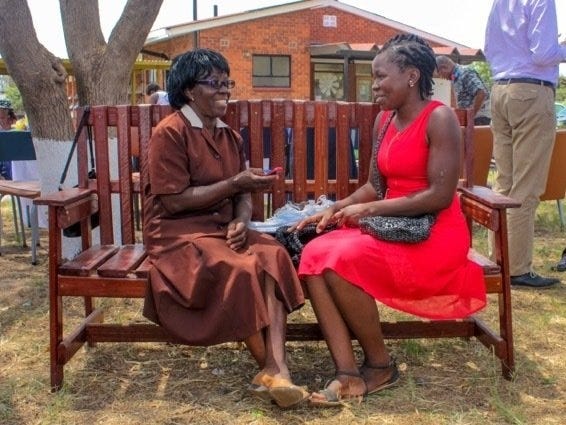Part II of a National Mental Health Rescue Plan
Building on improvements from Biden's American Families Plan, we need a post-Covid plan for mental health. Here’s what that should look like.
As I explained last week, Biden's American Families Plan is an incredible step forward for mental health – but it's still just a step. America's mental health crisis is of epidemic proportion, which warrants the creation of its own National Mental Health Rescue Plan.
With it now being Mental Health Awareness Month, there will be a lot of eyes on all leaders to see what they do next to help our nation’s mental health. And that next thing should absolutely be the second, some may say most foundational, part of a National Mental Health Rescue Plan – bolstering our mental health and addiction workforce. If we are going to be encouraging people to take a more proactive approach to improving their mental well-being and seeking help, leaders have to make sure that the system is capable of meeting their needs and the demand.
THE STATUS QUO WE SHOULD STOP SUPPORTING
This is a hard conversation to have. The way things currently are structured, our status quo – well, it’s not working for most people. Care is elusive, coverage inconsistent, and our entire approach to mental health continues to feel like an afterthought. But if we change our workforce, we can change that reality, as making it easier for people to access care – according to one survey from earlier this year, two-thirds of members of a national provider organization said that while demand for services was increasing, they had to cancel appointments, reschedule appointments, or altogether turn people away. It’s hard to see how a nation in such dire need of help will tolerate being told no, not now for too much longer.
To make it easier for people to access and pay for mental health care, we need a different way of thinking about workforce – one that helps us respond to needs in a more timely manner, and do so in a high quality and effective way. And if there ever was a time for leaders – especially President Biden's pick to lead the Substance Abuse and Mental Health Services Administration (SAMHSA), Dr. Miriam Delphin-Rittmon – to make that happen, this is that time. Studies show that the wait times for an outpatient appointment with a mental health clinician can last over a week to twenty five days to much longer. And appointment availability is just one part of the problem. Experience is another.
In part because 60% of U.S. counties have no psychiatrist, 46% of individuals know someone who has had to travel more than one-hour round trip to access mental health treatment. Once they get into care, they are met with even more barriers, especially those related to insurance coverage. Mental health office visits with a therapist are five times as likely to be out of network compared to non–mental health office visits, and these insurance barriers are often more significant in communities of color. The Black community has high rates of serious psychological distress, and increasing suicide rates have been reported among African American youths especially.
A FRAMEWORK FOR A BETTER MENTAL HEALTH & ADDICTION WORKFORCE
Solving these problems goes beyond simply adding more clinicians. Years ago my colleague Michael Talamantes and I were helping lead a workforce committee for Colorado’s work in our State Innovation Model, and trying to find a way for the state to better prepare for bringing mental health clinicians into over 300 primary care practices. We came up with this back of the napkin overview:
Current workforce – Take the clinicians we have out there in the field and retrain or prepare them to work in new settings. For mental health clinicians, this might be primary care or schools. The Eugene S. Farley, Jr. Health Policy Center even created a set of competencies that highlighted 8 competencies mental health clinicians needed to have to work successfully in primary care settings.
Future workforce – Provide prospective health care professionals with the appropriate training by making mental health a core curricular component of medical school education. In addition, train our future clinicians to understand what it’s like to work within a team-based, multidisciplinary setting.
Community workforce – Empowering everyone to perform tasks that traditionally clinicians would. There’s robust literature out there on it, and it seems to solve several problems at once. Creating a national plan for how to scale these models in the United States is one major initiative Well Being Trust is working on this year with our friends at Harvard Medical School.
Though this might seem simple and straightforward, there’s a lot of work that goes into properly addressing each of these areas. For example, in order to strengthen the current workforce, we need to consider financing and do the four things that would promote primary care integration, as recently identified by in a report commissioned by Well Being Trust and published by the Bipartisan Policy Center:
1. Establish core, minimum standards essential for integration;
2. Drive integration in new and existing value-based payment models;
3. Expand, train, and diversify the workforce for integrated care teams;
4. And promote the use of electronic health records, telehealth, and other technology to support integrated care.
Other such policy-related recommendations can be found in a paper I recently published with Anita Burgos, Enhancing the Capacity of the Mental Health and Addiction Workforce: A Framework. This is a framework that can allow us to drill a bit deeper than the above taxonomy by proposing three shifts and corresponding policy changes that need to take place at the clinical, community, and individual levels.
Changes that would make a positive difference at the individual level is what I’m going to focus the remainder of this post discussing, because after all, this is a newsletter about action. From pushing for policy change in your communities to starting a social movement for mental health, this newsletter’s goal is to share solutions and inspire you to put them to work. (That's also Well Being Trust's goal for this Mental Health Awareness Month, which is why we've provided more than 10 resources and videos to not just raise awareness about mental health, but help people DO something about it.)
WHAT CAN I DO?
It seems too simple to say, but we really need to learn how to be there for each other beyond just saying that that is the case. So that mental health is not just left to clinicians to manage, all of us should read up on evidence-based interventions to help friends, family, neighbors and any others we see struggling with mental health and addiction issues. Checking out http://empower.care/ is a great place to start understanding this broader approach to mental health.
If our country embraced models where every American layperson was equipped with the proper evidence-based training, that in and of itself would have a hugely positive impact on mental health. Studies support this statement. When one of his patients died by suicide, Dr. Dixon Chibanda, a psychiatrist in Zimbabwe, recognized that because he could not be everywhere at once, he needed a model that would allow for the people who were there – laypeople in this case – to do something. So, starting with grandmothers, the matriarchs of the village, he spent years testing the effectiveness of “lay health worker–administered, primary care–based, culturally adapted psychological intervention with education and support, vs usual care with education and support, for common mental disorders in Zimbabwe.” Chibanda found, as published in JAMA, that when participants were taught a structured approach to identifying problems and finding workable solutions, public health outcomes improved. And all it took was presenting new skills to people in the community.
To ensure that happens here, we need leaders like Miriam Delphin-Rittmon to, as Anita and I wrote:
· Invest in widespread mental health training for individuals in communities
· Develop outcome measures to accurately assess lay public interventions
· Implement novel pathways for referrals to additional mental health services
· Fund additional research on low-level mental health and addiction interventions in communities
But we also need you, reader. We need you to help us create a new mental health and addiction workforce that emerges in community, by community, and for community. It’s a disruptive idea, at a time when our nation has never more needed to disrupt the status quo.







Thanks Ben for this and I hope you keep writing.
I wonder if you are connected in to the folks at allcove in California? allcove.org. They are working with young people, local and state gov, and health systems to try to implement better community-based models of care for young people specifically. Fits directly in with the philosophy you're espousing here... you all should be in touch if you're not, happy to intro if need be.